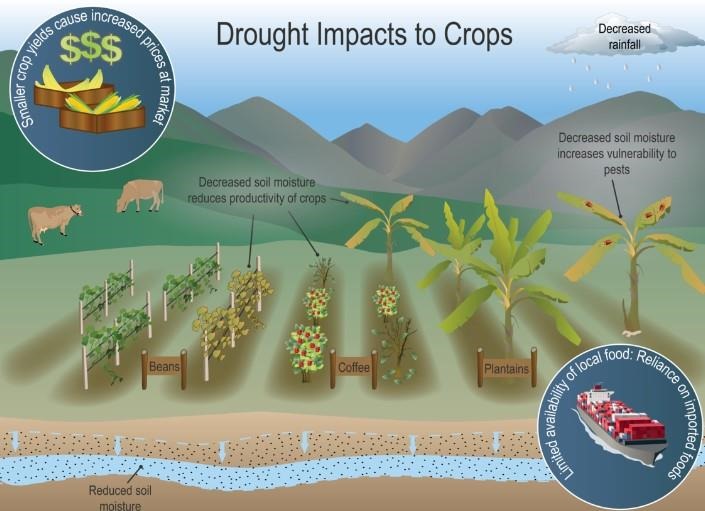By Eva Holupchinski and Josh Fain et.al
Introduction
Agricultural production in Puerto Rico and the U.S. Virgin Islands (USVI) is important for the region’s economy, food security, and rural livelihoods. Farms in the region are mostly small-scale and cultivate a wide variety of crops including plantains, vegetables, coffee, hay, and ornamental plants. Small-scale farms of 10 acres or less are much more common in the U.S. Caribbean than in the continental U.S. Relative to the continental U.S., where just 11% of farms are under 10 acres, 39% and 68% of farms in Puerto Rico and the USVI are 10 acres or smaller, respectively. While the variety of crops these farms provide is vital to the region, smaller financial margins can make them more vulnerable to climate-related hazards.
Of the many climate events that threaten agricultural production in the region, increasing drought is one of the most devastating. The agricultural sector is typically the first to feel the impacts of drought, since the majority of crops in the U.S. Caribbean are rainfed. Drought conditions can quickly lead to reduced crop yield, desiccation, and crop losses island-wide, unlike other hazards such as floods and landslides that occur on a much smaller scale (Wilhite, 2000). As the climate changes, droughts in the U.S. Caribbean are projected to become more frequent and intense (PRCCC, 2013). Implementing the use of cover crops, water retention ponds, and drought tolerant varieties can help reduce the impacts of drought.

Graphic showing how drought can impact crops in the U.S. Caribbean.
Recent Impacts in the Islands
From 2014 to 2016, the U.S. Caribbean experienced a long and intense drought that impacted a wide variety of crops from coffee to plantains and grass. Millions of dollars in crops were lost in Puerto Rico and the U.S. Virgin Islands, leaving farmers less able to cope with damages from the hurricanes that followed in 2017. Climate projections indicate this pattern of intense drought and storms will continue to worsen if global greenhouse gas emissions are not significantly curbed.
Spatial Impacts
Since 2000, all regions of Puerto Rico have been exposed to some level of drought conditions. The east and southeastern regions have experienced the most frequent droughts (Álvarez-Berríos et al., 2018). In 2014, the coffee-growing industry was among the most impacted by drought (Gould et al., 2015). In the 2015 drought, the most heavily impacted crops of Puerto Rico were grass, fodder, and plantains; together accounting for 85% of the $14 million in agricultural losses caused by drought (Puerto Rico Department of Agriculture, 2017). In 2015, the most impacted individual crop was plantain, of which $3 million were lost due to drought (Puerto Rico Department of Agriculture, 2017). In the USVI, the impacts of the 2015 drought were most notable in the eastern regions of St. John and St. Thomas and across the entire island of St. Croix (NRCS, 2016).
Temporal Impacts
Short-term Impacts
The effects of drought conditions are reflected relatively quickly in regional agriculture. The majority of crops in the U.S. Caribbean are not irrigated and therefore rely heavily on rainfall for moisture.
- As soil moisture decreases, crops desiccate and become more vulnerable to pests.
- Even short-term drought can cause significant damage to crops, particularly when it occurs during key stages of crop development, such as after planting or during flowering. Drought can stunt the growth of crops, resulting in a decline in the size and quality of produce.
- Consumers may expect to see higher prices for local food as farmers cope with lower yields and higher expenses.
- Limited water availability for washing produce may lead to sanitation and health issues for consumers.
Long-term Impacts
- Increasing drought will affect staple crops, and therefore the availability of local food. Imported food often has added preservatives and lower nutritional value, which can negatively affect human health (PRCCC, 2013; Gould et al., 2018).
- Coffee production in the region may be disrupted due to less optimal climate conditions and an increase in pests (Gould et al., 2015).
- Overuse of groundwater for irrigation could lead to more salt-water intrusion into important aquifers.
Cross-Sector Impacts
- Economic: Drought conditions lead to increased expenses for farmers which result in elevated prices for local food and an increased reliance on imported food products.
- Water Supply: Reduced freshwater availability can lead to conflicts between agricultural and other sectors.
Current Activities & Future Research Directions
Many agencies are working to reduce drought vulnerability in agriculture in the region, such as the Cooperative Extension - University of Puerto Rico, the Cooperative Extension - University of the Virgin Islands, and the USDA Natural Resource Conservation Service (NRCS) - Caribbean Area. Technical experts with NRCS are working to help producers in Puerto Rico and the USVI mitigate the effects of drought conditions. NRCS-recommended practices include the establishment of cover crops for improved water infiltration, the installation of efficient irrigation systems for effective water resource use, and the development of riparian buffers to reduce chemical and nutrient runoff when lands are bared by drought.
The Scientific Drought Committee of Puerto Rico works to advise the local government regarding recommended strategies for water conservation as drought conditions progress. Further research on drought-tolerant crops will help local producers adapt to more frequent drought events and decreased rainfall. This research is underway, and two varieties of drought-tolerant common beans were recently developed at an Agricultural Experiment Station in Mayagüez, Puerto Rico (PRCCC, 2013).
Source : usgs.gov